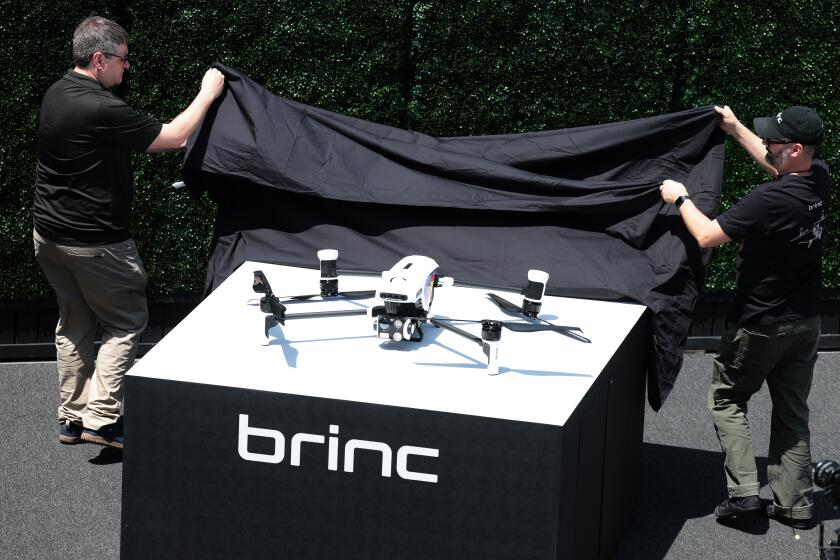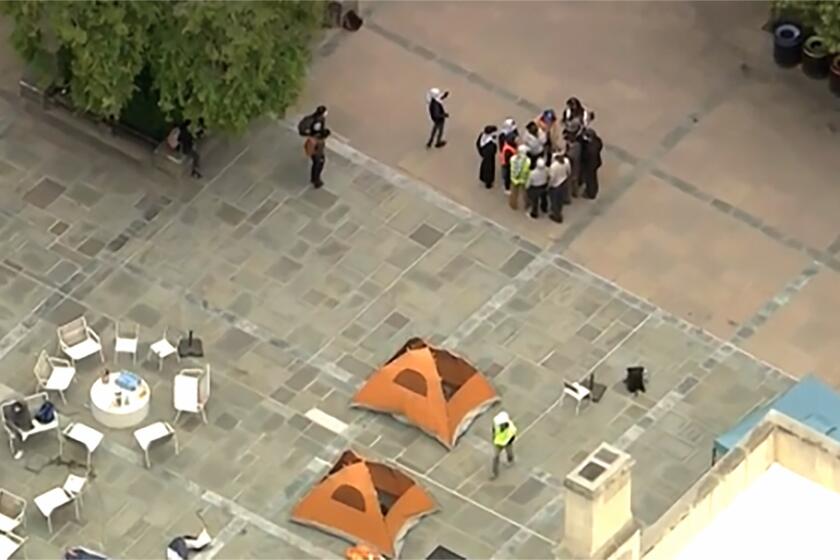Beepers Sending Mixed Signals on O.C. Campuses
The Capistrano Valley High School senior leaves no message, only his beeper number. Nobody seems to have Mustafa Said Naim’s home phone number. He answers the page quickly, a reporter’s phone number flashing on his Bravo Plus.
For two years he has worn a beeper because, he says, his parents “are overprotective.”
“My brother got hit by a car, and after that I couldn’t go out. If I wasn’t home at 10 o’clock sharp they’d get worried,” said Naim, who is from Afghanistan. “Having the beeper has been a lot better. Now, if I’m not home at 1 or whatever, they page me. At night, they page me a lot. Even though I’m 18, my parents don’t want me to see girls, so the girls page me, and I have to go to a pay phone to call them back, because my mom listens on the line.”
Long associated with young drug peddlers, beepers are emerging among Orange County teen-agers as the latest high-tech tool for parents to track their offspring. But some youths are also sporting pagers as vogue accessories in an array of neon colors and use them to keep in touch with each other.
“It’s quite common,” says Orange Police Lt. Timm Browne, who has even seen beepers on junior high school students.
“I think it’s a high-tech security link. It’s not an apron string, but it’s a sophisticated, reasonably acceptable method in society to stay in touch,” Browne says. “When I was a child, parents would lean out a window and whistle, and you would come home. . . . But bearing in mind this is California, with more cars than anywhere else, you’re not going to be able to lean out your door and call your kids home anymore.”
Since 1988, beepers have been outlawed on California high school campuses, partly because they are disruptive in class, but also because they are associated with drug dealers who are paged by customers.
And their reputation wasn’t helped by Amy Fisher, the New York high school student who shot the wife of her auto mechanic and alleged lover. In one of many sensational revelations, it was reported that Fisher prostituted herself and wore a beeper to class so customers could reach her.
Still, scores of teen-agers say they hide them away in purses or the inside of their waistbands and turn them off during classes, when parents and friends know where they are anyway.
Take Brea-Olinda High School, for instance. Administrators there say they’ve only confiscated two of the beepers this school year from students wearing them at their parents’ request and haven’t noticed many of the devices on campus. But several teen-agers interviewed said they just leave their beepers in their cars during class.
“My dad bought it for me for Christmas,” said David Rigney, 15, a Brea sophomore, “but my mom doesn’t want me to have it on at school. My mom is totally against it; she won’t even call me on it. I have at least four or five friends who have beepers, and some parents like them because it helps them reach their kids. But, like, a lot of parents are against them because they say they provoke drugs.”
*
Not Lew Morales. Living with earthquakes and teen-agers made him consider beepers for his whole family. Now he, his daughter, 16, and son, 19, never leave home without them.
If the Big One hits, he figures, phone lines may go out but the satellite carrying a pager signal won’t. If one of his kids is in trouble, they can beep him 24 hours a day and tag on a special 911 code at the end of their phone number.
“It gives me a lot of peace of mind. I feel so much better that I’m able to reach her,” Morales said of the black beeper his daughter discreetly carries in her purse daily to Brea-Olinda High School.
“She’ll be at a party and I’ll page her, and she’ll get upset and say, ‘Ah, that’s my dad checking up on me,’ ” Morales said. “But she’s gotta put up with it. It’s the ‘90s, and kids are going out in that strange world. And I want to be able to reach my daughter.”
When people ask her if she’s selling drugs, Antoinette Morales said, “it doesn’t bother me, but it happens all the time. They say, ‘Oh my God, she has a beeper, I wonder what she needs it for?’ ”
That stigma cast a swift and long shadow last month on the already disturbing slaying of an Orange County high school student.
Parents and students were shocked by the murder of Foothill High School honor student Stuart Tay. But beyond disbelief over the viciousness of his beating death there was surprise and, briefly, suspicion, at the news that the 17-year-old wore a beeper. Police said his killing was planned by five youths with whom he had allegedly conspired on a computer theft after they grew concerned Tay might turn them in. But some wondered if the pager meant he was also involved in drug sales too.
No, police concluded. Tay merely wore the baby-blue beeper so that his mother and girlfriend, Jennifer Lin, who also wore a beeper, could easily reach him.
When Tay disappeared on New Year’s Eve, it was his lack of response to his mother’s page that first signaled trouble.
“A little after 6 p.m., I started beeping him to say dinner would be ready soon,” Stuart’s mother, Linda Tay, said in an interview nine days after the youth’s body was discovered. “I do that quite frequently.”
At first, Linda Tay thought maybe her son had gone to a movie and could not get to a phone. By 9 p.m., though, she knew he had to be in some kind of trouble.
“Stuart has never not answered his mom when his mom beeps him,” said Alfred Tay, Stuart’s father.
He had worn the beeper for his parents’ peace of mind, but sources close to the investigation said it was on Tay’s pager that he first made contact with the teen-ager now accused of masterminding his killing.
In his pocket, the device was found crushed by the blows he suffered and buried with him in a shallow back-yard grave.
*
Although the devices are more commonly seen in affluent communities, parents like Lew Morales say it has little to do with money.
Contrasted with a cellular phone’s initial cost of up to $140, a beeper’s monthly service fee, usually under $15 and as low as $7, is affordable to most.
“I know 10 of my son’s friends who have them, so parents can reach them and to communicate with each other,” Lew Morales said.
The family’s phone bill has dropped in half since he bought the beepers six months ago, he says. It costs 4 cents per call to page one of his kids anywhere, but it could be a $2 toll call to track down one of them in Newport Beach.
Most of the students at Capistrano Valley High School who wear beepers, says Naim, “wear them as status symbols. They aren’t even activated. You ask them for their number and they don’t have one. If you don’t pay your monthly dues, the beeper doesn’t work.”
Of the “100 of the kids at our school who have them, two people at the most deal (drugs). All the rest are just wearing them for fashion,” he says.
“We have seen an increase in kids using them,” says Charles Walker, general manager of L.A. Central Cellular. “It’s a fad. The majority of them don’t need them, but it’s a status symbol.”
While some youths still wear standard brown and black beepers, a lot of the more style-conscious are buying clear and neon models aimed at their age group.
“Everybody’s getting the clear ones. If a person brags about it, then everyone will make fun of them. So they purposely get one that’s noticeable so they don’t have to talk about them,” Naim says.
Frequently, “it’s the people who go to clubs, the ones with the baggy pants,” who wear beepers, he says. “Like, the gang members, they don’t have none. The trendy people are only now starting to get them.”
Other students say no one group of students--the athletes, the brains--have made beepers their trademark.
Riuko Yamamoto, an 18-year-old Brea senior, has had her beeper for just a few weeks and got it because “I live by myself, and people complain when I’m not at home, and so my parents can reach me anytime, because they live in Japan.”
*
Denise Jay, vice principal at Brea-Olinda High School, said the school bans beepers for the same reason it prohibits cameras or radios in class: They are a distraction.
“We don’t want kids being beeped and having to go to a phone and leave class,” she said. Students found with pagers the first time have them taken away, to be reclaimed at the end of the school day. That’s only after school officials try and call the home “so the parent is aware that the student is carrying a beeper.” The second time, Jay said, the beepers are confiscated until semester’s end.
“They were made illegal on our campus because of the disruption in class and the concern that it would be for drug deals,” said Trisha Ginsburg, a senior at Los Alamitos High School. “But we have the Orange County High School of the Performing Arts, so a lot of those students wear beepers because they have agents.”
A senior at Woodbridge High School in Irvine, who would only give her name as Susan because the devices are banned there, wears a beeper because she has an everyday baby-sitting job, and her employers page her if they need her to pick up groceries or change their plans. She has had the pager for six months; her employers pay for it, but her friends and parents also use it to reach her, she said.
At University High School in Irvine, student Eileen Hsu says “I think mostly the rich kids wear them. . . . But at our school, anyone found with a beeper will be given detention and suspension. The three people I know wearing them are always busy. They wear them because they’re never home, so an answering machine doesn’t help at all.”
Times staff writer Jodi Wilgoren and student contributors Hallie Kim and Julie Kim contributed to this report.
More to Read
Start your day right
Sign up for Essential California for news, features and recommendations from the L.A. Times and beyond in your inbox six days a week.
You may occasionally receive promotional content from the Los Angeles Times.






